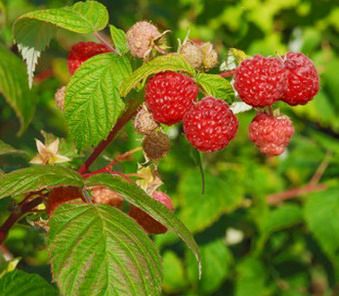How to Plant and Care for Raspberries
Curious about how to plant and care for raspberries? Read on!
Types of raspberries:
Red and Yellow- The red and yellow are identical the only difference is the pigment is missing from the yellow types. Produce new canes from perennial root systems. Typically Zones 3 and 4 to zone 8 - some varieties we carry here at Gertens include - Amity, Anne, Autumn Britten, Boyne, Caroline, Fall Gold, and Heritage
Black raspberries and Purple raspberries - Clump forming and form new plants from base of the floricanes. Both marginally hardy in Minnesota, most varieties are zone 5.
Fruiting Habits:
Ever-bearing- Many raspberries are mislabeled ever-bearing they are truly fall-bearing if labeled ever-bearing.
Fall-bearing- Produce a large crop in the fall followed by a smaller crop the next summer. In many cases the fall-bearing varieties are mowed annually so they only produce fruit in the fall. The fall crop is produced on the primocane and the summer crop is produced on the floricanes.
Summer-bearing- Produce one large crop between July and August. The primocanes on summer-bearing varieties do not produce fruit; the fruit is produced on the floricanes.
Floricane - Primocane in the 2nd year of growth.
Primocane - 1st year new growth.
Soil Preparation and Planting
- When preparing the soil it is best to prepare the soil a season before planting; prepare the soil with organic matter like compost or manure.
- Conduct a soil test to determine the pH and nutrient levels; soil bags can be found in Gerten’s Lawn and Garden department and sent to the University of Minnesota for analysis.
- Raspberries need full sun.
- Raspberries require a well drained, moderately fertile soil, with a soil pH ranging from 6.0-7.5, use a tester to make sure your pH is correct.
- The soil should ideally have Phosphorous levels of 25ppm, potassium levels of 100ppm
- Raspberries are self-fertile so only one variety is needed for fruit production.
- Plant raspberries every 2-3 feet apart.
Raspberries need to be supported; the fruiting canes become heavy and will break or hang on the ground.
Pruning Summer-bearing Varieties
- After harvesting has ended, prune out the floricanes, any of the canes that have fruited should be removed. If thinning on new shoots is required, thin at the same time as pruning old canes. Leave 3-4 canes per foot of row.
Pruning Fall-bearing Varieties
- For the simplest method mow all canes to the ground in the late fall or early spring when plants are dormant. This will result in only one crop of fall berries.
- For two crops, after the floricanes have fruited, prune out only the old canes in the fall similar to the summer-bearing pruning technique.
